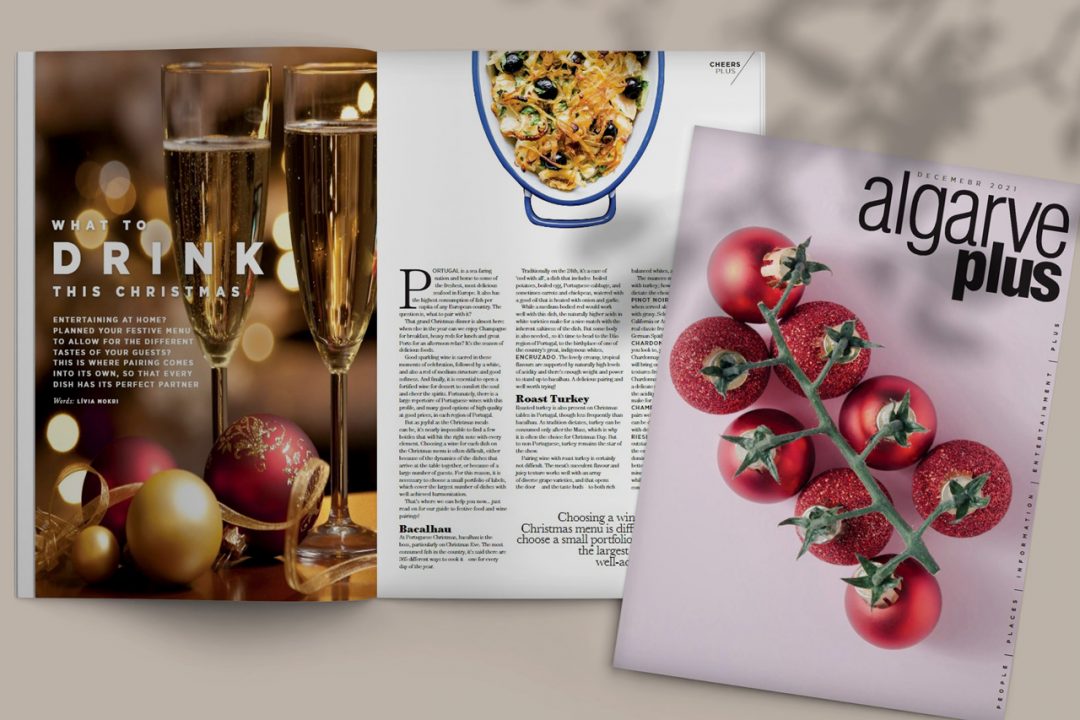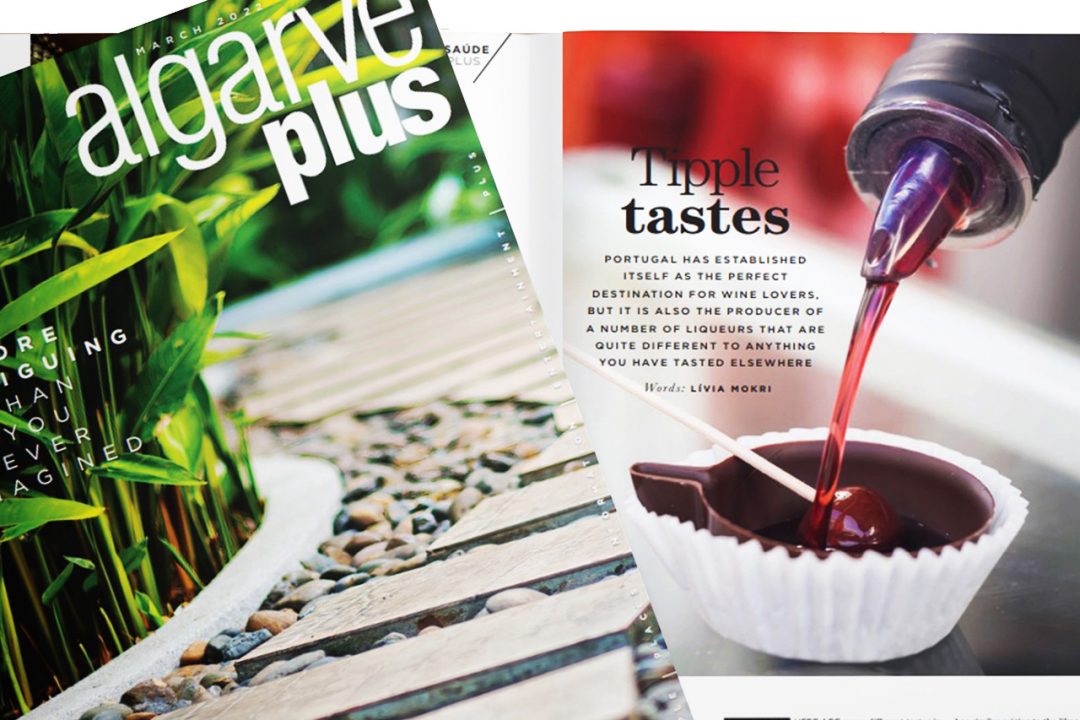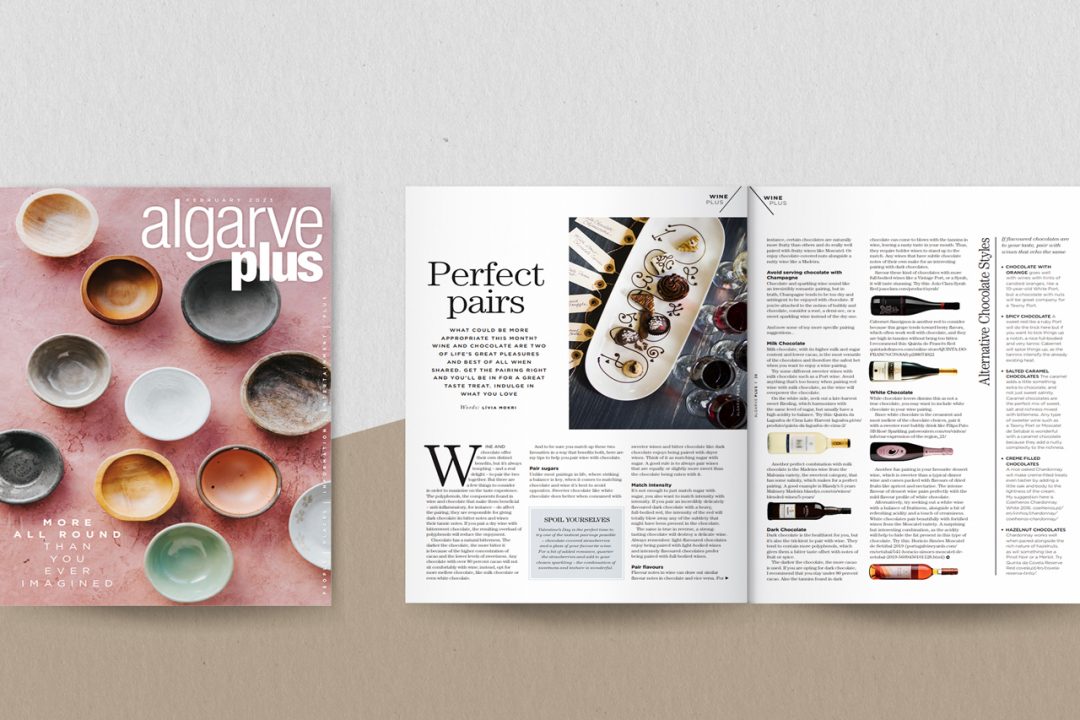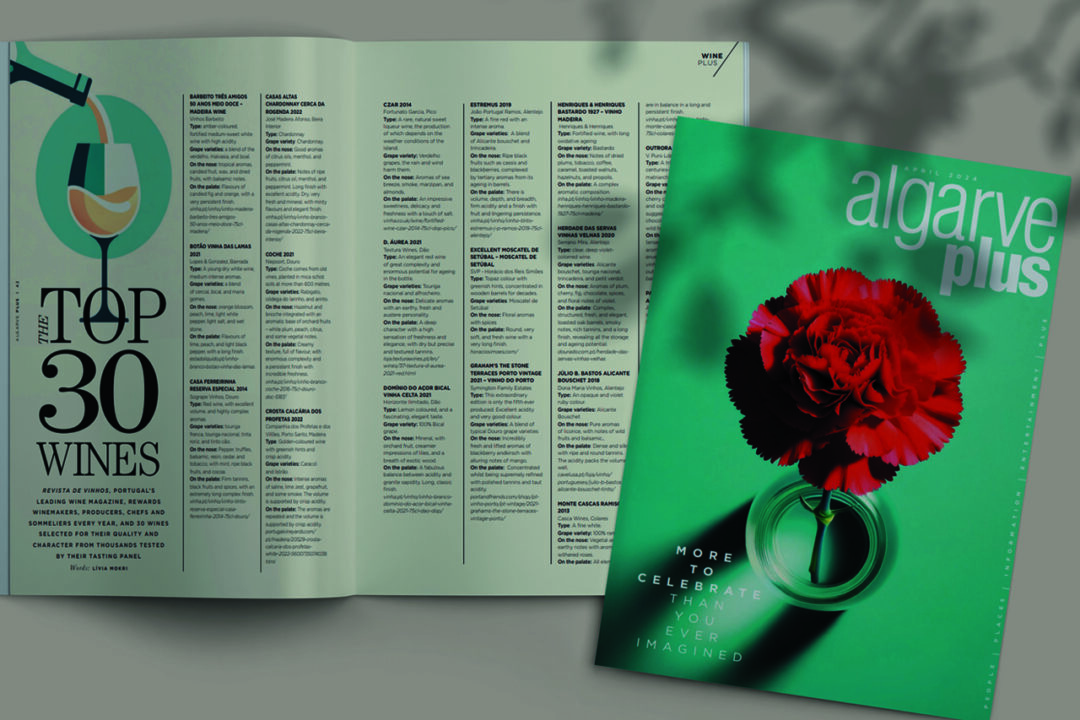What to drink this Christmas – Every dish has its perfect partner in wines – this is where pairing comes into its own!
I am happy to share that my new article in the Algarve Plus Magazine has been already published!
If you want to know more about what to drink with Christmas dishes, read my new writing here online below.
The magazine is readable online or downloaded for free here.
Enjoy!
Or read here the whole article:
What to drink this Christmas
Portugal is a sea-faring nation and home to some of the freshest, most delicious seafood in Europe. There’s a huge variety of fish and seafood brought in daily and Portugal has the highest consumption of fish per capita of any European country. The question is, what to pair with it?
The Christmas dinner is almost here: when else in the year can we enjoy Champagne for breakfasts, heavy reds for lunch, and great Ports for afternoon relaxation? It’s the season of delícious foods.
Good sparkling wine is sacred in these moments of celebration, followed by a white and also a red of medium structure and good softness. And finally, it is essential to open a fortified wine for dessert to comfort the soul and cheer the spirits. Fortunately, there is a large repertoire of Portuguese wines with this profile, and many good options of high quality and good prices, in each region of Portugal.
But as joyful as the Christmas meals can be, it’s nearly impossible to find a few bottles that will hit the right note with every element. Choosing a wine for each dish on the Christmas menu is often difficult in several aspects, either because of the dynamics of the dishes that arrive at the table together or because of the extremely high number of guests. For this reason, it is necessary to choose a small contingent of labels, which cover the largest number of dishes with well-achieved harmonization or, at worst, that do not conflict.
That’s where we can help you now – just read on for our guide to festive food and wine pairings!
Bacalhau
Portugal is a sea-faring nation and home to some of the freshest, most delicious seafood in Europe. There’s a huge variety of fish and seafood brought in daily and Portugal has the highest consumption of fish per capita of any European country. The question is, what to pair with it?
At Portuguese Christmas, the bacalhau is the boss. Although there are other traditional dishes, currently the dish that most Portuguese families eat on Christmas Eve is bacalhau.
Bacalhau is specifically salted cod and appears everywhere across Portugal, in a variety of different forms. The most consumed fish in the country and it’s said there are 365 different ways to cook it; one for every day of the year.
Bacalhau is part of the national identity and history and at Christmas, this presence is even stronger, due to the ecclesiastical tradition of fasting on Christmas Eve. Not being able to eat meat, the bacalhau made a tradition at Christmas tables. It is eaten all over the country, accompanied by boiled potatoes, boiled egg, Portuguese cabbage and sometimes carrots and chickpeas. This is the ‘Cod with all’, watered with a good oil at the end that is heated with onion and garlic.
Whilst a medium-bodied red would work with this food, the naturally higher acids in white varieties are also a nice match with the inherent saltiness of the dish, but… it also needs some body. So, time to head to the Dão region of Portugal, to the birthland of one of the country’s great, indigenous white varieties, Encruzado. The lovely creamy, tropical flavors are supported by naturally high levels of acidity and there’s enough weight and power to stand up to bacalhau. A delicious pairing and well worth trying!
Roast Turkey
What wine goes with roast turkey?
Roasted turkey, although less frequent, is also present on Christmas tables in Portugal. As tradition dictates, turkey can only be consumed after the Mass, which is why it is a dish often eaten on Christmas Day.
Pairing wine with roast turkey is actually not as difficult as it seems. Turkey is white meat and has low-fat content. The meat’s succulent flavor profile and juicy texture make it the perfect match for an array of diverse grape varieties, hailing from various regions all over the globe; from rich, balanced whites, to earthy, fruit-driven reds, letting you sip the best wines with roasted turkey. So, your wine pairing should ideally be either a full-bodied white wine or a medium-bodied red, with low or medium tannin and relatively high acidity.
The nuances matter when pairing turkey with wine.
Turkey is flavorful meat that pairs easily and wonderfully with a wide variety of wines. Depending on how you prepare your turkey and what flavors you add to the meat, gravy, and stuffing, you have many options for intriguing and delicious wine and turkey pairings.
Easy reds are an obvious choice of wine pairing, but there is always room for more creative wine and turkey pairings.
How you prepare your turkey will dictate the choice of wine pairing.
- Pinot Noir
You can’t go wrong with this choice when served alongside a classic, roasted turkey with a side of gravy. Pinot Noir is an incredibly versatile wine. The wine’s bright high acidity, as well as extreme versatility on the table, make it a solid choice for pairing not only with turkey, but also the handful of sides that will cover the rest of your plate.
You can select a New World Pinot Noir for a lighter, fruit-forward profile with wines from California or Argentina . Or you might prefer an old-world Pinot Noir selection from France’s Burgundy region or even a German Spatburgunder.
- Chardonnay
No matter which region you look to, you can’t go wrong in pairing Chardonnay with your turkey. Chardonnay is a grape that boasts abundant variety. The oaky notes of a Chardonnay will bring out more complex flavors and textures from the turkey, while a fruity and crisp Chardonnay such as Chablis or Burgundy offers a more delicate mouthfeel. Regardless of your choice of Chardonnay, the acidity and fruitiness are constants that make for an excellent pairing with your turkey.
- Champagne
Champagne is an excellent wine to pair with turkey. It contains high acidity, which pairs well with traditional roasted turkey flavors and can be drunk throughout the meal—even during dessert. Champagne pairs especially well with a deep-fried turkey as it offsets the crunch of the skin and is great at bringing out the grassy, herbal flavors of the bird.
- Riesling
A dry, German Riesling is an outstanding choice for a wine and turkey pairing. But forget the explosively sugar-ridden bottles that used to dominate the market! dry Riesling is back and better than ever. The drink’s high acidity and minerality add a delicious touch to the turkey while keeping your taste buds soothed and comfortable.
5. Beaujolais
Another popular choice for roast turkey. The Beaujolais Cru is a young wine that is light and high in acidity, making for a distinct and enjoyable wine and turkey pairing.
Or the Beaujolais Nouveau is also a popular choice for turkey if you would like to keep your meal light. This light and fruity variation of the wine will complement the turkey, and the drink’s low alcoholic content will effortlessly highlight sweeter flavors.
6. Sangiovese
The Italian Sangiovese can be an excellent choice for pairing with turkey. Its subtly spicy flare helps bring out more unique, savory flavors in your turkey meal.
Stilton cheese
If there’s a cheese deserving attention also all on its own, it just might be Stilton. Made entirely from cow’s milk sourced from three English counties, the tall cylinders stand apart for their loose crumb and creamy white paste striated with blue-green lines of Roquefort. Those crumbs melt into a rich, buttery texture on the tongue and carry a wallop of flavor: smoky, nutty, and savory, with a bright acid tang.
But what to drink with such a commanding cheese?
Creating wine and cheese pairings is challenging, but a good pairing is well worth the effort. Especially, when it comes to blue cheese, finding a suitable wine can be a touch more difficult. This pungent cheese features strong flavors that can clash severely with many wines. In general, it can be said that the bolder the cheese, the bolder the wine. Blue cheeses can make light red wines and white wines taste bitter. These cheeses need strong wines or sweet wines to balance their flavors. Let’s see some of the best wine and cheese pairings for Stilton.
- Port wine
A traditional pairing for Stilton is the Port wines which you can pair with other types of blue as well. The intensity of Port makes it a good match for the pungent flavors of many blue ones.
The challenges posed by tannins and high alcohol are offset by the wine’s intense grapey sweetness. Look for an LBV (Late Bottled Vintage) bottle in your wine shop, which is ready to drink upon purchase (as opposed to Vintage Port, which is meant to be cellared).
- Sherry
Sherry is another type of fortified wine with a strong flavor profile. Like Port, the sweetness of the wine works well with the pungency of the cheese. A very old, oxidative sherry like the nutty Oloroso is particularly good, as the richness of the cheese balances some of the shocking visceral dryness of the wine.
- Malbec
Malbec is a particularly suitable choice if you’re eating Stilton. This medium to full-bodied red with notes of dark fruits (such as blackberries and plums), cocoa, and leather is a great partner for blue cheese. Especially if Malbec undergoes oak aging and also features hints of tobacco. The complex flavors of blue cheese and Malbec marry together beautifully.
- Cabernet Sauvignon
Cabernet Sauvignon is another medium to full-bodied red option. While it shares some similarities to Malbec, it does feature stronger tannins, making it the more intense of the two. It’s also a particularly good option for stronger blue cheeses like Roquefort. If you pair Cabernet Sauvignon with a milder blue, you might lose some of the more subtle notes of the cheese.
- Tokaji Aszu
This might surprise you but some white wines also make for a great pairing with Stilton. One excellent option to consider is Tokaji Aszu. This sweet, white dessert wine features notes of dried apricots, figs, dates, and nuts. All these flavors appear also in the golden, sweet Tokaji wines of Hungary of which are labeled with a number from 2 to 6 that denotes their sweetness (6 being the richest).
Dessert is a big deal in Portugal and no meal is complete without something sweet to finish. Especially at Christmas time. It’s also a great opportunity to taste a couple of sweet and fortified wines.
If you have a sweet tooth, read on!
Bolo Rei
Quite literally ’King Cake’, is a delicious Portuguese dessert that’s traditionally eaten over Christmas, actually shaped in the style of a crown. Soft, sweet dough is embedded with dried fruits, and nuts and baked until crunchy. A lovely tradition in Portuguese families is to hide a small token in the cake somewhere, and whoever finds it has to either make or buy the cake the following year!
With a sweet dessert like the Bolo Rei, the best to drink something that brings out the fruity character, without overpowering the dish itself. Moscatel de Setubal is perfect for this; tangy and sweet with lovely flavors of apricots, nectarines and honey. Make sure you taste a younger bottle as they can get quite smokey, dark and nutty with age; that’s also delicious but not quite right for Bolo Rei!
Christmas pudding
For those of you unfamiliar with a British Christmas pudding it’s a steamed pudding full of dried fruits like raisins, currants and figs, often with some citrus peel added.
But what wine goes well with Christmas pudding?
The type of wine depends on your pudding. There is an argument that you don’t need anything to drink with the classic Christmas pudding, especially if you’ve sloshed brandy all over it but if you’re pairing other courses of the Christmas meal you might fancy a small glass of something sweet.
Some puddings are much darker and stickier than others. If you serve a rich sweet wine like a Moscatel or a sweet Sherry you can make an already rich pudding overwhelmingly rich. On the other hand, a lighter dessert wine such as a Sauternes or a glass of sparkling wine can get lost amidst all the rich spicy fruit.
In my view, the type of wine that works best is a dessert wine with flavors of orange or apricot. Christmas Pudding is delicious with the similarly flavored aged Tawny Port and the rich Madeira. Try a 10 or 20-year-old Tawny which is slightly less sweet than a Ruby Port or a Late Bottled Vintage and I think the nutty flavours work well together. Serve it as they do in Portugal, lightly chilled.
Less-sweet wines such as non-botrytized, late-harvest Rieslings can also match less-sweet desserts. The rule of thumb is the sweetness of the wine should be equal to or greater than that of the dessert. Otherwise, you won’t be able to taste the wine.
If you’re a beer fan you could also drink a bottle of barley wine (an extra-strong ale) with the pudding. Or serve your pud with a small well-chilled glass of Grand Marnier or other orange-flavored liqueur.






No Comments Found